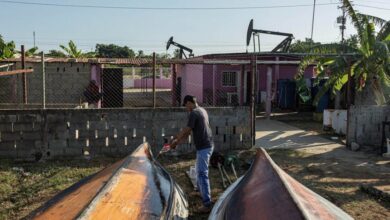Milei’s Bold Zero Emission Gamble Amid Argentina’s Economic Challenges

President Javier Milei’s plan to eliminate monetary emissions aims to curb Argentina’s inflation and stabilize the exchange rate. This ambitious move faces challenges from low central bank reserves and a slowly recovering economy.
President Javier Milei has made a decisive move to stop monetary emissions to tackle Argentina’s soaring inflation and ease currency pressure. This strategy, part of the ‘phase 2’ of the economic stabilization plan announced in late June, faces significant hurdles, including the Central Bank’s limited reserves and a sluggish economy.
The Milei administration has halted monetary emissions, which it blames for the country’s high inflation rate of 271.5% in June. The Central Bank had already ceased issuing currency to finance the Treasury, whose expenditures plummeted due to Milei’s aggressive fiscal policy. The Bank will also refrain from issuing pesos to purchase dollars in the official market. Instead, any pesos emitted will be “sterilized” by selling an equivalent amount of dollars in the financial exchange market.
This policy targets the ‘contado con liquidación’ (CCL) dollar—a market where local assets are bought with pesos and sold for dollars in the U.S. This alternative market emerged due to strict regulations on accessing dollars in the official exchange market, leading to a significant gap between official and financial exchange rates. These restrictions, known locally as ‘cepo cambiario,’ have caused economic distortions, with fluctuations in alternative exchange rates quickly translating into higher inflation.
Private estimates suggest that net reserves are negative by $6 billion, making it challenging for the Central Bank to intervene effectively in the exchange market. The official exchange rate adjusts at a modest 2% per month, far below the inflation rate, leading to increased pressure on alternative markets. This pressure prompted the authorities to adopt the new scheme, which, on its debut, significantly reduced the CCL dollar’s value.
“The measure responded to a gap exceeding 50% and a sterilization mechanism for pesos via reserve purchases. This should revalue the peso due to its new scarcity. However, the decision is not without risks: economic activity and reserves will take longer to recover,” stated CMF Bank in a report.
The government believes this “deepening of the monetary program will contribute to the disinflation process” and narrow the exchange rate gap, facilitating an “orderly elimination of exchange restrictions.”
Challenges and Expert Opinions
The government’s decision to intervene in the CCL market reflects a lack of incoming dollars and significant outflows due to the energy balance. “They had no choice. With no dollar inflows and significant outflows, they now intervene in the CCL. They will dry up the peso market, likely narrowing the gap and calming the situation,” Leonardo Piazza, director of LP Consulting, explained to EFE.
Piazza believes Milei’s approach to achieving fiscal surplus and cleaning up the Central Bank’s balance sheet is “correct.” Still, in the interim, the market and exporters are demanding the lifting of exchange controls and reserve accumulation. This task becomes more complex with the new scheme.
“I believe the program entered a delicate phase with many well-achieved elements. Still, the government now needs to lift the exchange controls, and to do so adequately, it needs a new comprehensive agreement with the International Monetary Fund (IMF),” Piazza noted.
The slow accumulation of reserves raises concerns about when Milei will fulfill his promise to lift the ‘cepo’ and Argentina’s ability to meet its sovereign debt obligations denominated in dollars. To dispel these doubts, the government recently announced that the Treasury would purchase $1.6 billion from the Central Bank to cover the interest on bonds maturing in January 2025.
Economic Impact and Future Prospects
Despite these measures, dollar-denominated bonds fell on Monday, and Argentina’s risk premium rose to 1,555 basis points. The financial markets still need to be convinced about the government’s ability to stabilize the economy and meet its debt obligations.
The Milei administration’s aggressive fiscal policies and commitment to ending monetary emissions are bold steps toward economic stabilization. However, the challenges are immense. The Central Bank’s negative net reserves limit its ability to manage exchange rates effectively, and the economy’s slow recovery complicates efforts to lift exchange controls and build reserves.
The government’s strategy hinges on narrowing the exchange rate gap, reducing inflation, and stabilizing the peso by creating a controlled scarcity of the currency. While these measures may provide short-term relief, the plan’s long-term success depends on structural economic reforms and increased foreign investment.
Argentina’s experience highlights the delicate balance between monetary policy, exchange rate management, and economic stability. The country’s inflation and currency devaluation struggles are not unique in Latin America, where many nations grapple with similar issues. Global market dynamics, commodity prices, and domestic policy decisions often influence the region’s economic stability.
A Path Fraught with Risks
President Javier Milei’s strategy to curb inflation and stabilize the Argentine economy by halting monetary emissions represents a significant gamble. The potential impact of these measures on the country’s economic future is substantial. The limited reserves and the slow pace of economic recovery present formidable challenges, making the outcome of this plan a matter of significant interest.
The government’s ability to navigate these challenges and implement structural reforms will be critical in determining the success of Milei’s economic stabilization plan. The importance of collaboration with international financial institutions like the IMF and attracting foreign investment cannot be overstated. These factors will be essential for building the necessary reserves and achieving long-term economic stability, providing a sense of hope and optimism for the future.
As Argentina moves forward with these ambitious plans, the lessons learned, and the outcomes will provide valuable insights for other Latin American countries facing similar economic challenges. The region’s economic future depends not only on effective policy implementation and the resilience of its economies but also on international cooperation and the ability to navigate global uncertainties.
Also read: Argentina Faces Recession and Job Losses Amid Austerity Measures
In the meantime, the world’s eyes remain on Argentina, watching how the country manages this complex economic transition and whether Milei’s bold moves will pave the way for a more stable and prosperous future.





